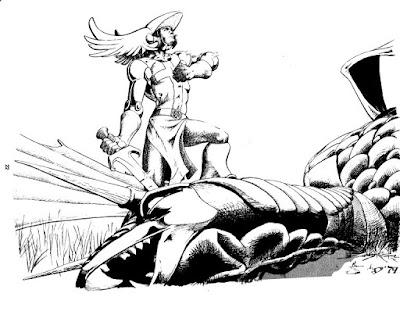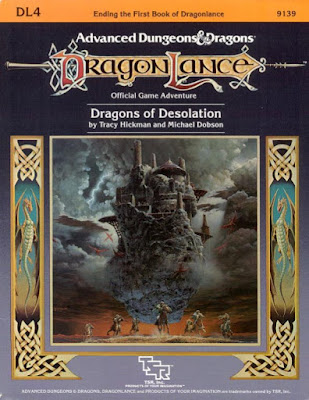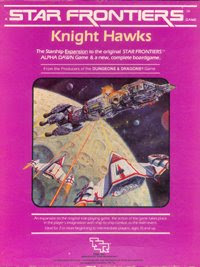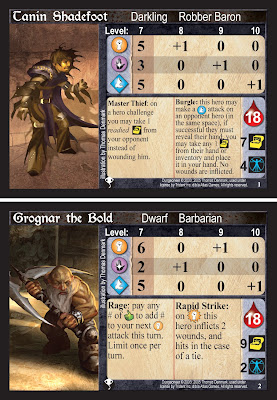Swords & Wizardry has inspired me to read through my copies of old TSR products lately, and it has been stirring up deep feelings of nostalgia, so I thought it would be terribly fun to do a top 10 list of favorite TSR products.
Any list of this nature is likely to be controversial, but this is what stirs up those warm feelings in me and sparks my imagination. Anyone who played D&D as a teen in the 80's probably shares many of the same favorites.
My first encounter with D&D was around 1981. This is the same year the Moldvay Expert set was published. AD&D was "completed" with the release of Deities and Demigods the prior year, and B.A.D.D. (bothered about dungeons & dragons) was still a year or two away.
I will begin my list at #10, which has the distinct honor of belonging to Tom Moldvay's D&D Expert Set.

Why, out of the thousands of products made by TSR would this make it all the way up to the #10 spot? The cover is great, the writing is superb, and it has one of the best adventures ever written...The Isle of Dread!
In this set we are introduced to iconic, powerful spells: fireball, lightning bolt, polymorph, cloudkill, the walls (fire, ice, stone), and reincarnation! It had all the essential charts from basic included, and character classes described from level 1 to 14 and beyond. It even had a great primer on how to create your own fantasy world. Of all the designers TSR employed, I admire Moldvay for his ability to condense a concept to its essence and explain it clearly. He also had a way of providing just enough to stir the imagination, but wasn't heavy handed, he did not do all the thinking and creating for you.
To give an example of Moldvay's conciseness, on page X4 he describes Two-handed weapons with a single paragraph of about 27 words. In the Rules Cyclopedia this paragraph is expanded to over 35 words - and is repeated at least 5 times, sometimes with just slightly different wording (a very bad thing in a rules book). This makes for over 140 words of redundancy in a book already crammed to the brim, over 300 pages, with tiny text - and somehow says less than Moldvay accomplishes in the Basic and Expert sets with just 2 64 page booklets. (in all fairness I love the Rules Cyclopedia for many reasons, and it does have a lot more "stuff", but it is exceedingly and unnecessarily long-winded)
With this set I never felt the need to buy the basic set (I could always look at a friends copy). This game was really a bargain. By todays standards it has "too much gameplay" - the customers can get so much use out of it they don't need to keep buying as much stuff.
As much as I like the oft touted Keep on the Borderlands, I am especially fond of The Isle of Dread.

What Moldvay did for the D&D rules, he applied that same precision and bountiful imagination to this wilderness adventure. As undeniable proof I present exhibit #1, the map of the Isle of Dread:

This just-detailed-enough island has everything you'd want to explore: jungles, mountains, caves, villages, ruins (the best place for adventures!), tar pits, a tree village, even a pirate camp!
It has a little monster manual in the back with 15 new monsters in it, all of them interesting and useful. In particular the phanatons and rakasta intrigued my young developing imagination. The description of the kopru, a very strange monster, had the word "sphinctered" (mouth) - I asked my mom what it meant, she busted up laughing and said that it was like your butt. I still didn't understand back then. Really.
If you still harbor any doubt about how great this adventure is, here is the coup de grace, the first map of Mystara:

An entire fantasy world was in that module! Each country had a paragraph description that gave no more than essential information so that a young creative DM could let his imagination run with it and flesh it out.
Unfortunately, my clearest memory of running this adventure also happened to be the very first time I DM'd. I remember giving the players the blank map of the island and making them painstakingly map out each hex as they explored it, I put them in the jungle area with nothing else to do. Well, they only lasted about 3 sessions before they left to find a better DM. I was heart broken, but it was a valuable lesson - realism is boring and the DM's job is to create an exciting experience for the players with something cool to do or find each session.
When I think about the many bloated adventures and books out there, I'm amazed at how much Moldvay was able to put into that little 32 page module.
The expert set had so much going for it, I'm not sure it gets the credit it deserves in the way the basic set does. For me, though, it brings back fond memories of high adventure with more powerful characters against more powerful monsters, intelligent swords, strongholds and so much more.
You may notice that my set, pictured at top, looks quite mint - the dice still have their crayon and wrapper! This is thanks to the wonders of eBay, alas my original set has long since disintegrated and been lost.
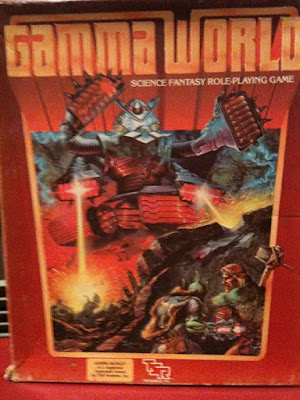 Gamma World is the first RPG I played that wasn't D&D. I was introduced to GW with the 1st edition, but the 2nd edition was the first one I owned, so that edition is Gamma World in my nostalgic mind.
Gamma World is the first RPG I played that wasn't D&D. I was introduced to GW with the 1st edition, but the 2nd edition was the first one I owned, so that edition is Gamma World in my nostalgic mind.

